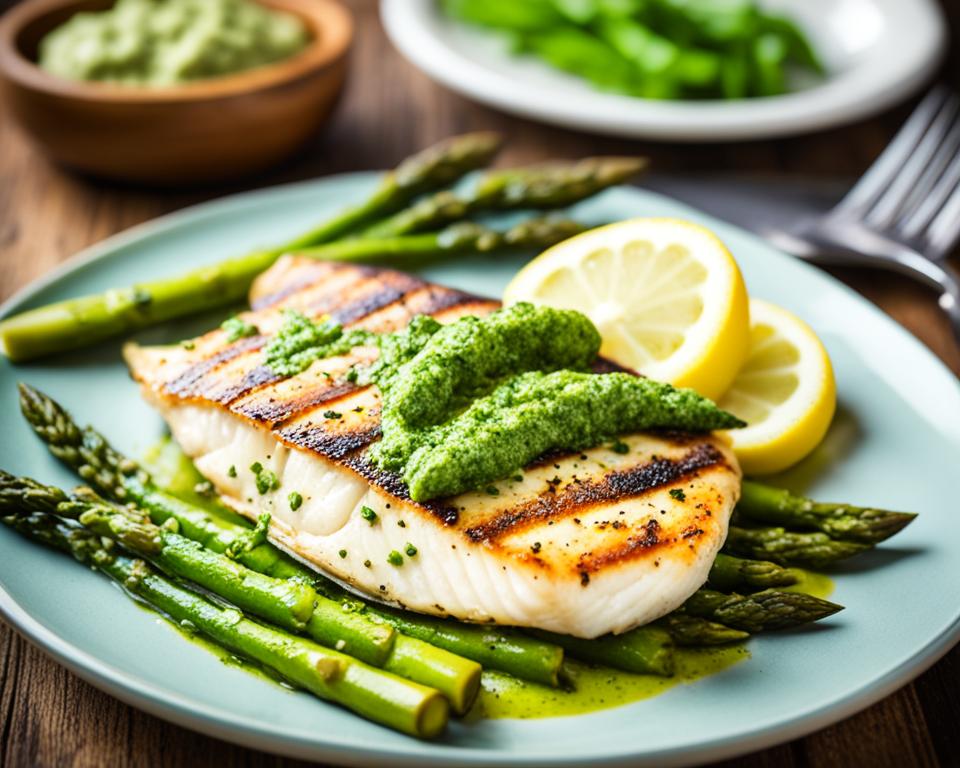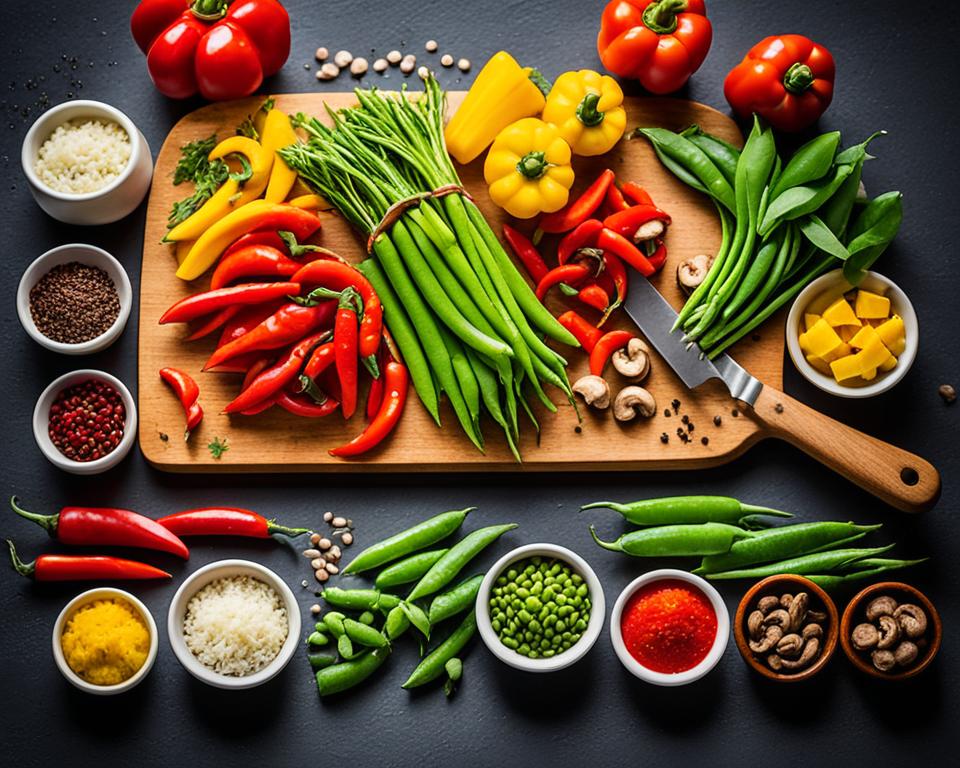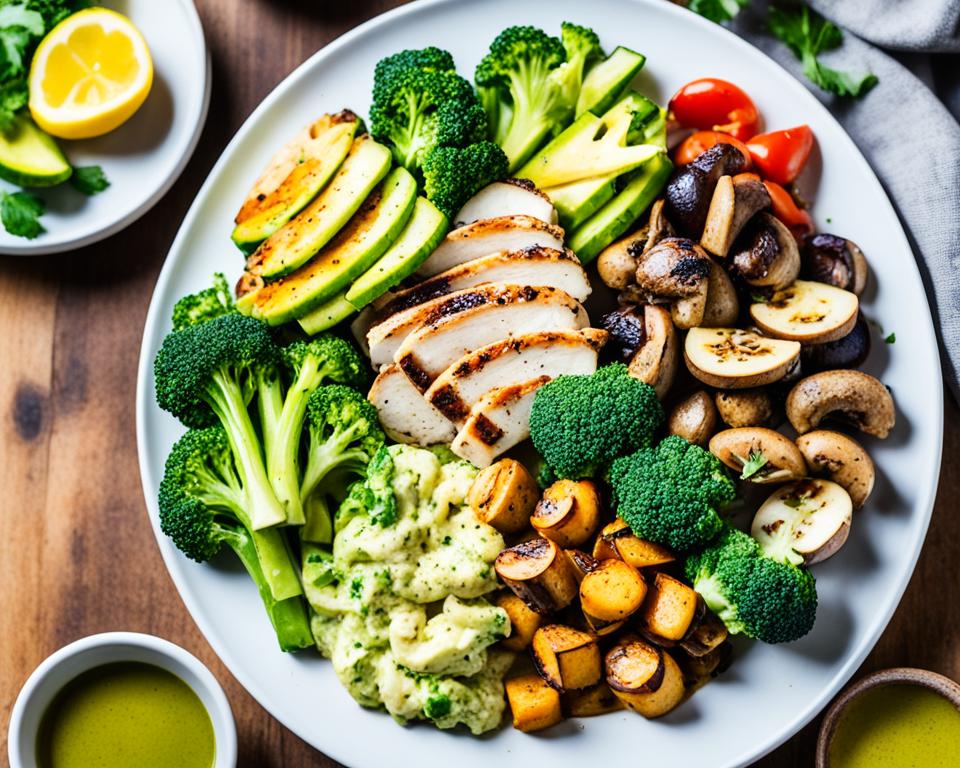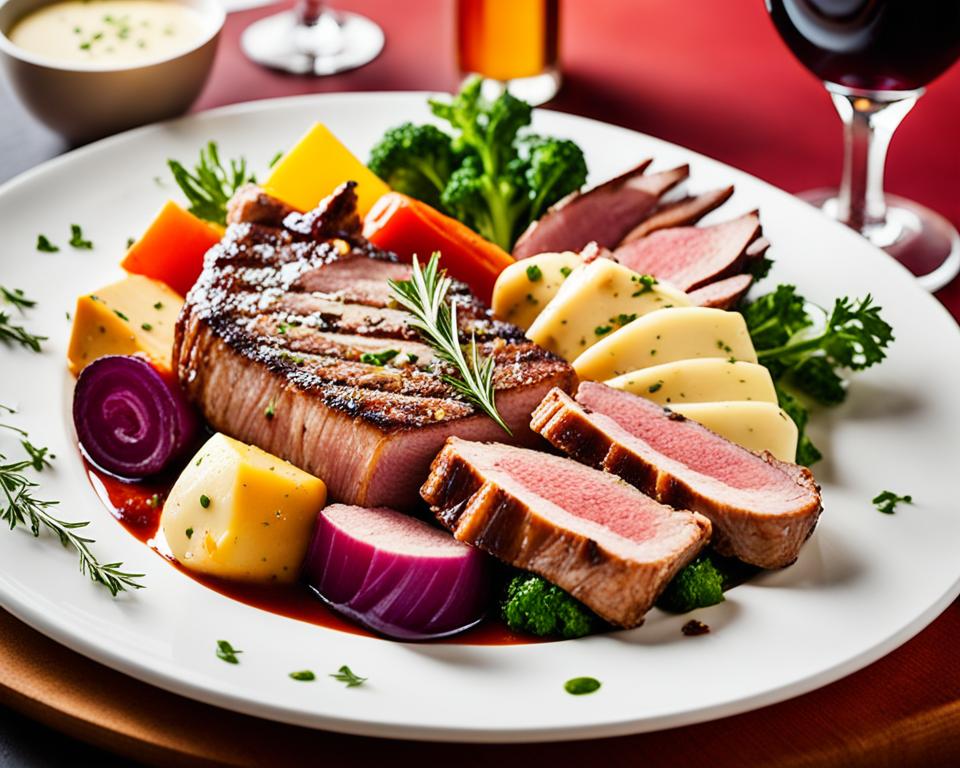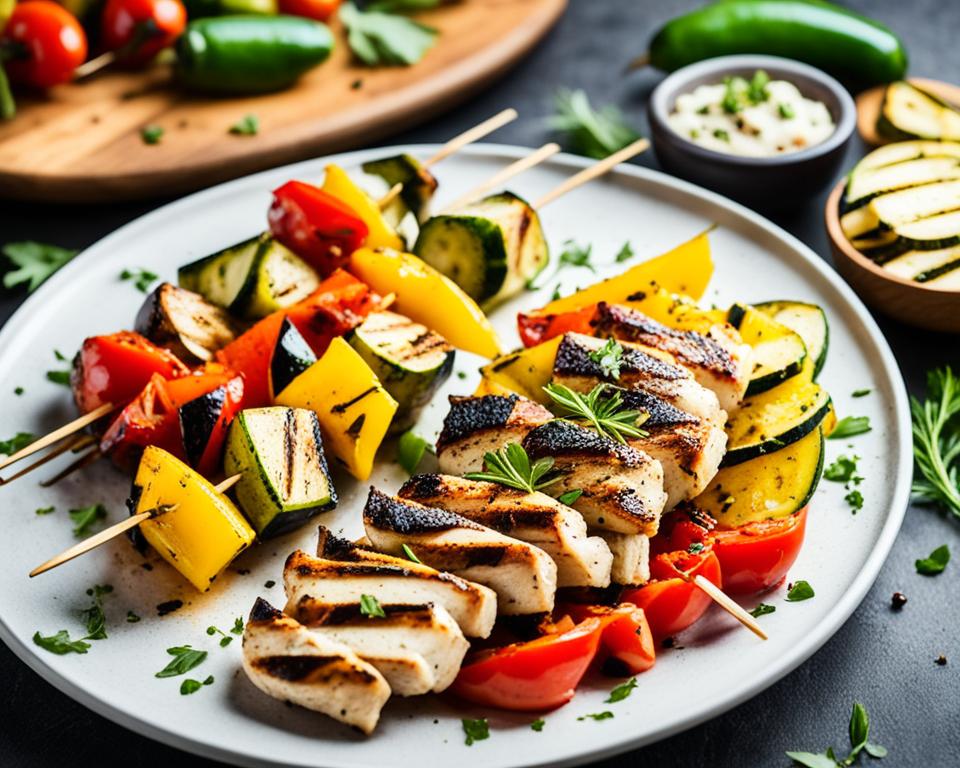Need a fresh, tasty dinner that comes together real fast? Then you’ll love my easy Garlic Butter Oven Baked Tilapia. Seasoned with a classic blend of lemon, garlic, melted butter, and paprika, this simple dinner really hits the spot! And, it’s all done in just 20 minutes.
Key Takeaways:
- Garlic Butter Oven Baked Tilapia is a quick and easy dinner recipe that can be made in just 20 minutes.
- It is seasoned with a blend of lemon, garlic, melted butter, and paprika, resulting in a delicious and flavorful dish.
- This recipe requires minimal ingredients and is perfect for those looking for a low-carb, gluten-free, and Keto-friendly option.
- Tilapia is a healthy choice as it is high in Omega-3 fatty acids and a good source of protein.
- Whether you’re cooking for yourself, your family, or guests, this tilapia dinner recipe is sure to impress!
Flaky Garlic Butter Baked Tilapia
Looking for a delicious and hassle-free way to prepare tilapia? Look no further than this flavorful recipe for Flaky Garlic Butter Baked Tilapia. Unlike other baked fish recipes that require various toppings and breadcrumbs, this recipe keeps it simple and lets the natural flavors shine. All you need are three key ingredients: lemon, garlic, and butter. The result is a mouthwatering dish that is not only super easy to make but also low carb, gluten-free, and Keto-friendly.
This garlic butter tilapia is a perfect choice for those who appreciate simplicity and incredible taste. Whether you’re a seafood lover or a picky eater, this recipe will surely please your taste buds. The combination of garlic and butter adds richness and depth to the mild flavor of tilapia. The result is a moist and flaky fillet with a buttery, zesty bite.
Not only does this recipe deliver in terms of taste, but it also provides a healthy meal option. Tilapia is a good source of protein and is rich in Omega-3 fatty acids, which are essential for heart health. With the added benefits of being low in carbs and gluten-free, this dish is versatile and fits into a variety of dietary lifestyles.
Cooking Tips:
- For the best results, use fresh ingredients such as fresh garlic and lemons.
- Make sure to season the tilapia fillets generously with salt, pepper, and paprika to enhance the flavor.
- To achieve a moist and tender texture, avoid overcooking the fish. It should easily flake with a fork.
- Feel free to customize the recipe by adding your favorite herbs and spices.
- For an extra pop of flavor, garnish the baked tilapia with chopped parsley and lemon slices.
With its simplicity, health benefits, and deliciousness, this garlic butter tilapia recipe is sure to become a go-to for quick and satisfying meals. So why not give it a try tonight?
Is Fresh or Frozen Tilapia Best?
In general, when it comes to tilapia, the debate between fresh and frozen can leave you in a bit of a pickle. You may be wondering which option is the best for taste and quality. Let’s dive into the details and find out.
Quality and Freshness
When it comes to fresh tilapia, the key is getting fish that has been caught, cleaned, and put up for sale within about 48 hours. This ensures that you’re getting the highest quality fish with optimal freshness. However, finding fresh tilapia can be a challenge, especially if you don’t live near a coastline or a fish market.
On the other hand, frozen tilapia is a convenient and reliable option. Most fish that you find in stores has been frozen at some point to preserve its freshness during transportation. Frozen fish is processed and frozen quickly after the catch, which helps lock in the flavors and nutrients.
| Fresh Tilapia | Frozen Tilapia |
|---|---|
| Requires access to freshly caught fish | Available year-round |
| Higher chance of optimal freshness | Processed and frozen quickly after catch |
| May be harder to find in landlocked areas | Convenient and readily available |
Taste and Texture
When it comes to taste and texture, both fresh and frozen tilapia can deliver delicious results. Fresh tilapia might have a slight edge in terms of flavor due to its optimal freshness. However, properly handled and prepared frozen tilapia can taste just as good. The key is to thaw frozen tilapia properly and cook it with care to retain its natural flavors and succulence.
Remember: Fresh or frozen, the quality of the tilapia and how it’s cooked can make a significant difference in taste and texture.
Convenience and Availability
One of the advantages of frozen tilapia is its wide availability. You can find it in most grocery stores year-round, regardless of your proximity to the coast. This makes it a convenient option for those who don’t have easy access to fresh fish. Frozen tilapia also offers the flexibility of storing it in your freezer, allowing you to have it on hand whenever you need it.
“Frozen tilapia is a versatile choice that can be easily incorporated into a variety of recipes, making it a convenient go-to option for many home cooks.”
The Verdict
In most cases, frozen tilapia is an excellent choice. It offers convenience, availability, and quality that is on par with, and in some cases, even better than fresh tilapia. When properly handled and cooked, frozen tilapia can deliver delicious results that rival fresh fish. So, whether you choose fresh or frozen, rest assured that you can enjoy a flavorful tilapia dish.
Is Tilapia Healthy?
When it comes to the healthiness of fish, tilapia often gets mixed reviews. While wild-caught fish is generally considered the healthiest option, many food experts argue that properly farmed fish, including tilapia, can also be a nutritious choice.
Tilapia is known for being a good source of Omega-3 fatty acids, which are essential for brain health and reducing inflammation in the body. These fatty acids have been linked to numerous health benefits, including a lower risk of heart disease and improved cognitive function.
Additionally, tilapia is a lean source of protein, making it an excellent option for those looking to increase their protein intake without consuming excessive amounts of fat or calories.
The Importance of Quality
However, it’s important to note that not all tilapia is created equal. The quality of tilapia can vary depending on the source, farming practices, and feed used.
Some tilapia farms prioritize sustainability, ensuring that their fish are raised in clean environments and fed a healthy diet. These farms often adhere to strict standards and regulations to minimize any potential negative impacts on the environment or fish quality. Opting for tilapia from these reputable sources can help guarantee a healthier and safer choice.
On the other hand, there have been concerns about certain farming practices that may compromise the healthiness of tilapia. Some tilapia farms have been criticized for overcrowding fish, using antibiotics or growth hormones, and feeding them an unhealthy diet. These factors can negatively impact the nutritional profile of the fish and raise concerns about potential contaminants.
It’s essential to do your research and choose tilapia that comes from reputable sources with high standards and sustainable farming practices. This way, you can ensure that you’re getting a healthy and safe product.
Comparison to Other Fish
If you’re looking for alternative fish options that are also rich in Omega-3 fatty acids, consider these nutritious choices:
| Fish | Omega-3 Fatty Acids per 3 oz (grams) |
|---|---|
| Salmon | 1.8 |
| Mackerel | 1.7 |
| Sardines | 1.5 |
| Tilapia | 0.7 |
| Tuna | 0.2 |
As you can see, while tilapia may not have the highest Omega-3 content compared to other fish like salmon or mackerel, it still provides a valuable amount of these essential fatty acids.
Tilapia is a healthy choice that can be part of a well-balanced diet, especially when sourced responsibly. Incorporating different varieties of fish into your meals can diversify your nutrient intake and promote overall health.
Recipe Ingredients
Get ready to create a delicious and flavorful meal with these essential ingredients:
| Ingredients | Quantity |
|---|---|
| Tilapia Fillets | 4 medium-sized fillets |
| Salt and Pepper | To taste |
| Dried Thyme | 1/2 teaspoon |
| Dried Oregano | 1/2 teaspoon |
| Ground Paprika | 1/2 teaspoon |
| Butter | 4 tablespoons, melted |
| Fresh Garlic | 2 cloves, minced |
| Fresh Lemon Juice | 2 tablespoons |
| Lemon Zest | 1/4 teaspoon |
| Lemon Slices | For garnish |
| Red Pepper Flakes | For garnish |
| Chopped Parsley | For garnish |
Prepare to elevate the flavors of your tilapia fillets with these ingredients. The combination of herbs, spices, and fresh lemon will create a mouthwatering dish that will impress your family and friends.
How to Make Baked Tilapia
Follow these simple steps to create a delicious and flavorful baked tilapia dish that will impress your taste buds.
Prepare the Tilapia Fillets
Start by seasoning the tilapia fillets with a blend of salt, pepper, paprika, thyme, and oregano. This combination of spices will enhance the natural flavors of the fish and add a delightful aroma.
Arrange the seasoned fillets in a 9×13 baking dish, ensuring they are evenly spaced.
Mix the Garlic Butter Sauce
In a mixing bowl, whisk together melted butter, fresh garlic, lemon juice, and lemon zest. This flavorful butter sauce will infuse the tilapia with a tangy and aromatic taste.
Pour the garlic butter sauce over the tilapia fillets, making sure each fillet is coated evenly.
Bake the Fillets
Preheat your oven to 375°F (190°C).
Place the baking dish with the seasoned and sauced tilapia fillets into the preheated oven.
Bake the fish for approximately 10 to 12 minutes, or until the fillets flake easily with a fork. The fish should be tender and moist, with a perfectly cooked texture.
Take care not to overcook the tilapia, as it can become dry and lose its delicate flavor.
Serve and Enjoy!
Once the fillets are baked to perfection, remove them from the oven.
Garnish the baked tilapia with a sprinkle of red pepper flakes and chopped parsley for an added kick of flavor and a touch of freshness.
For a visually appealing presentation, add lemon slices on top of the fillets to showcase the citrusy essence.
Your mouthwatering baked tilapia is now ready to be enjoyed. Serve it alongside your favorite side dishes, such as roasted vegetables, steamed rice, or a refreshing salad.
Experience the delightful combination of tender and flaky fish with the savory garlic butter sauce. Each bite is a burst of deliciousness that will leave you craving for more.
| Ingredients | Quantity |
|---|---|
| Tilapia Fillets | 4 medium-sized |
| Salt and Pepper | To taste |
| Dried Thyme | 1 teaspoon |
| Dried Oregano | 1 teaspoon |
| Ground Paprika | 1 teaspoon |
| Butter | 4 tablespoons, melted |
| Fresh Garlic | 2 cloves, minced |
| Fresh Lemon Juice | 2 tablespoons |
| Lemon Zest | ¼ teaspoon |
| Lemon Slices | For garnish |
| Red Pepper Flakes | For garnish |
| Chopped Parsley | For garnish |
Serving Suggestions
Looking for the perfect side dishes to complement your delicious baked tilapia? Here are some mouthwatering options:
A Smashing Side
Tender potatoes go wonderfully with baked fish, so I recommend serving these yummy fillets with a side of Crispy Parmesan Smashed Potatoes. The crispy outer layer and creamy interior of these potatoes will elevate your tilapia dinner to new heights. For a balanced meal, add a refreshing green salad, and voila, dinner’s done!
A Gift of Goodness
If you’re looking to get your veggies and starch all baked up at once, why not try my Spring Vegetables and Potatoes Baked in Parchment? This delightful dish combines fresh seasonal vegetables and tender potatoes, all baked to perfection in parchment paper. Feel free to substitute whatever veggies are freshest in your area to add your own personal touch.
Sweets to the Sweet
For a sweet follow-up to your tilapia dinner, indulge in some decadent desserts. Treat yourself and your loved ones to a heavenly serving of Creamy Keto Chocolate Mousse or enjoy a plate of My Family’s Traditional Baklava. These delightful desserts will leave you satisfied and craving for more.
With these delectable side dishes and sweet treats, your tilapia dinner will be a memorable and satisfying experience.
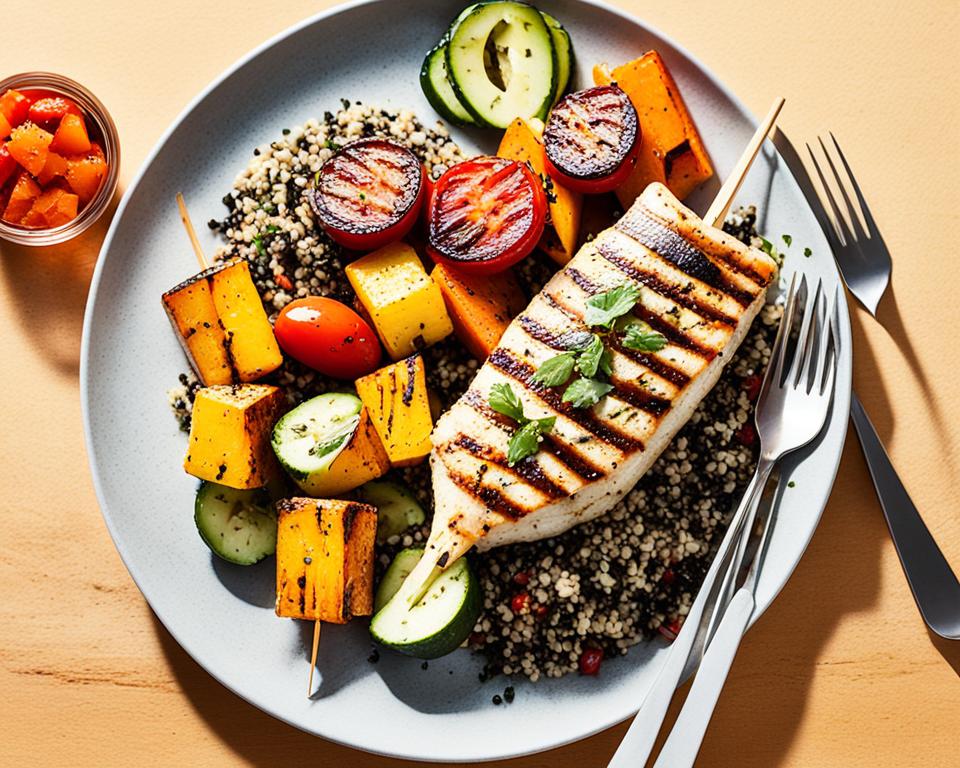
| Side Dish | |
|---|---|
| 1. | Crispy Parmesan Smashed Potatoes |
| 2. | Spring Vegetables and Potatoes Baked in Parchment |
| 3. | Creamy Keto Chocolate Mousse |
| 4. | My Family’s Traditional Baklava |
How to Store and Reheat Leftovers
When it comes to enjoying leftover tilapia, proper storage and reheating techniques are key to preserving the flavor and texture of the fish. Follow these simple steps to ensure your stored tilapia remains fresh and delicious:
- To refrigerate, store cooled leftover fillets in an airtight container to prevent air from affecting the quality of the fish. Place the container in the refrigerator and keep the leftovers for up to 3 days.
- If you want to freeze the leftover tilapia, start by placing the fillets in a single layer on a baking sheet or platter. Freeze them until they are solid. Once frozen, transfer the fillets into freezer bags, pushing out as much air as possible before sealing. Frozen tilapia can be stored in the freezer for up to 3 weeks.
When it’s time to reheat the leftover tilapia, follow these steps:
- If the fish is frozen, thaw it before reheating. Place the fillets at room temperature while the oven preheats to 350°F.
- Arrange the fillets in a baking dish and cover them with foil to prevent them from drying out during reheating.
- Bake the fillets in the preheated oven for 8-10 minutes, or until they are heated through.
It’s essential to note that reheating may affect the texture of the fish, making it slightly less moist than when it was freshly cooked. However, the reheated tilapia will still be tasty and enjoyable.
If you follow these storage and reheating instructions, you can savor the flavors of your tilapia leftovers without compromising on taste or quality.
Conclusion:
In conclusion, this quick and easy tilapia dinner recipe is perfect for a delicious and satisfying meal. Whether you choose to bake, grill, or pan fry your tilapia, you can’t go wrong with the flavorful seasonings and simple ingredients. Impress your family or guests with a restaurant-quality dinner that can be made in just 20 minutes. So go ahead and whip up a tasty tilapia dinner recipe tonight!
FAQ
What makes this tilapia recipe quick and easy?
This tilapia recipe is quick and easy because it only requires a few simple ingredients, including lemon, garlic, and butter. Additionally, it can be prepared and cooked in just 20 minutes.
Does this recipe use any special toppings or breadcrumbs?
No, this recipe does not require any special toppings or breadcrumbs. It relies on the flavors of lemon, garlic, and butter to enhance the taste of the tilapia.
Is frozen tilapia as good as fresh tilapia?
Yes, in most cases, frozen tilapia is just as good as fresh tilapia. Frozen fish is often processed and frozen quickly after being caught to maintain its freshness. However, it’s important to choose reputable sources and check the standards and feed used in the farming of the tilapia.
Is tilapia a healthy choice?
Yes, tilapia is a healthy choice. It is high in Omega-3 fatty acids and is a good source of protein. While wild-caught fish is generally considered the healthiest, properly farmed tilapia can also be a nutritious option.
What ingredients do I need to make this baked tilapia?
To make this baked tilapia, you will need tilapia fillets, salt, pepper, dried thyme, dried oregano, ground paprika, butter, fresh garlic, fresh lemon juice, lemon zest, lemon slices, red pepper flakes, and chopped parsley.
How do I make baked tilapia?
To make baked tilapia, season the fillets with salt, pepper, thyme, oregano, and paprika. In a separate bowl, whisk together melted butter, garlic, lemon juice, and lemon zest. Pour the mixture over the seasoned tilapia and bake in the oven for 10 to 12 minutes, or until the fish flakes and is fork-tender.
What side dishes pair well with baked tilapia?
Baked tilapia goes well with tender potatoes, such as crispy Parmesan smashed potatoes. Additionally, you can try serving the tilapia with a green salad or baked vegetables and potatoes in parchment packages.
How do I store and reheat leftover tilapia?
To store leftover tilapia, refrigerate it in an airtight container for up to 3 days. If you want to freeze the leftovers, place them on a baking sheet or platter to freeze them solid before transferring them to freezer bags. To reheat, thaw the fish (if frozen), preheat the oven to 350°F, and bake the fillets covered with foil for 8-10 minutes, or until heated through.

